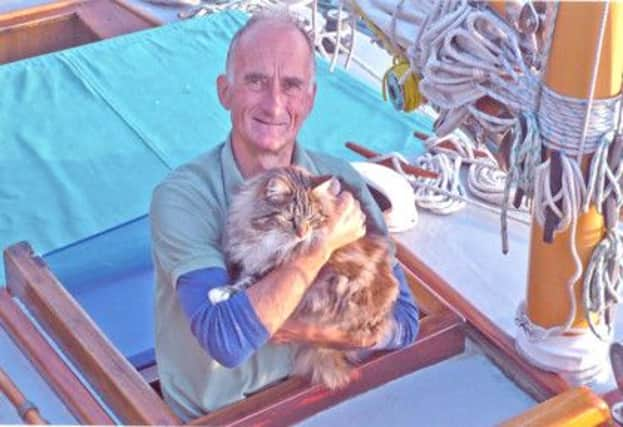Obituary: Ian Hawick, sailor


Ian Hawick was the kind of sailor who impressed other sailors. He took his 35-foot, engineless, wooden, gaff scooner Brünnhilde the 300 miles from South Queensferry to Shetland 24 times, accompanied by his wife Grizel and latterly by three, very long-haired, 15-pound Norwegian Forest cats.
He was a self-made man, teaching himself sailing as a boy with model yachts on Inverleith Park pond and accumulating enough know-how at the age of 15 to buy, with three friends, a converted lifeboat for £20 in Aberdour, Fife. They sailed it across the Forth to Granton.
Advertisement
Hide AdAdvertisement
Hide AdGrizel and friends think sea-faring skills came to Ian through the family gene pool from Shetland where his grandfather was a master mariner and great-grandfather a fisherman. His sailing confidence seemed second nature and inspired other yachtsmen to use the wind and tide more and depend less on engines. His was real sailing. A friend remembers him on a small boat off the west coast sailing without a rudder and just using the sails to go where he wanted.
Ian was a private man of few words, huge generosity and steely determination. No boating bluster and bravado to impress. But he would rise to a challenge such as sailing successfully against the formidable six-knot tide off Yell in Shetland to win a bet. Were it not for a serious stomach ailment that plagued his adult life, he would have been a vegan. He hated any cruelty to animals.
Ian went to Heriots school in Edinburgh, left at 15 and served his apprenticeship to become a lithographer. Printing, graphics and later painting and photography filled his landward life.
He worked for several printing firms in Edinburgh including McLagan and Cumming, Nelsons and the map publishers Bartholomews.
Meanwhile, he worked his way through several boats. Sea Hound, another lifeboat converted for sailing, was next after the first boat was destroyed on the breakwater at Granton in a storm. Ian used the rigging salvaged from the first boat. Mudlark, his third sailing lifeboat followed.
He was no dinghy sailor and all his boats would weigh more than a tonne. In 1964 he bought a 20-foot Stroma yawl, Gazelle, sailing her twice to Cruden Bay north of Aberdeen and in 1966 began his passionate attachment to Brünnhilde, based on a Tancook Whaler, a Nova Scotia working boat from the early 1900s.
Jack Kersley, a friend from Queensferry and Forth river pilot, had a model of the boat as inspiration and so in 1966 began the elaborate build project.
Her hull would be made in Baltasound, Shetland, by Sandisons boatyard. Duncan Sandison preferred larch for the clinker planking but when none was available had mahogany shipped in.
Advertisement
Hide AdAdvertisement
Hide AdIslanders thought the builder was balmy as this was not a very Shetland-looking craft like the local Sixareens or Shetland Model sailboats. She became known there as the “Balti-boat”. The hull was shipped as deck cargo to Leith and then into a shed at Cramond Brig where over seven years Ian fitted her out before being craned in at the Hawes Pier in Queensferry in June 1974.
Among friends helping Ian prepare the boat was Grizel Baillie, a primary school teacher. “I started painting her in 1969 and I am still painting her today,” she says. The two were married in 1970.
Brünnhilde was a boat like no other on the Forth – wood, not fibreglass, and a sleek, low shape that defied even the roughest sea. While not brilliant to windward Ian would storm past racing yachts on a reach.
“He was determined not to have an engine,” friend Brian White, from Queensferry Boat Club, remembers.
She was named Brünnhilde because Ian and Grizel liked Wagner and the boat was a double-ended craft like Viking or Nordic longships. You could almost hear The Ride of the Valkyries by some sea-going grand orchestra as the boat with Ian at the helm in the box-like cockpit aft would charge down the Forth towards Inchkeith island. Ian said he never turned right leaving the Forth estuary and his voyages with Brünnhilde would always take him north towards Shetland.
His summer visits to Shetland were like pilgrimages – back to Unst where Brünnhilde was built and to anchor off his grandfather’s former house at Collafirth in north Mainland.
The passages back to Scotland and the Forth were often wearing with Ian steering for up to 19 hours at a stretch, being fed tea from the cabin by Grizel. Ian constantly tweaked the sail plan of up to five sails at once to get the best performance from the boat. While modern yachts can reef down their sails in seconds, it could take 15 minutes to reduce sail on Brünnhilde.
During the winter the boat was craned out at Port Edgar and the perfectionist Ian would spend days pampering what some friends called his wife number one. The sight of Ian manoeuvring the 6.5 tonne Brünnhilde into its marina berth without an engine and using the anchor and ropes would draw admiring nods of approval from other yachtsmen.
Advertisement
Hide AdAdvertisement
Hide AdThe couple’s three huge cats adapted well to life at sea and would tuck themselves into safe corners of the cabin if it was rough and be clad in harnesses on deck. At the Hawick’s Queensferry house, Ian built a large caged runabout area in his garden and even planted several Norwegian pines so the cats would feel at home.
In his 40s Ian contracted Achalasia, a tightening of the lower gullet muscles which made it difficult to eat. Surgery in 1982 eased the condition but it was to return. In September during a second operation surgeons discovered the cancer which was later to kill him.
Even with this illness, Ian planned further sails and even hoped to start a small printing business in his home. He was not easily daunted.